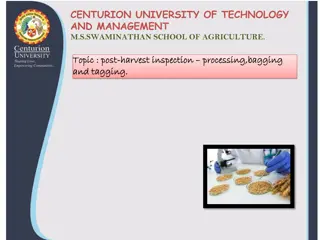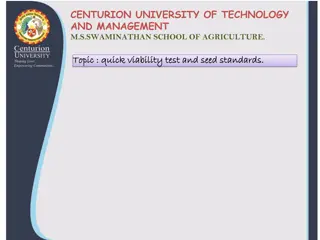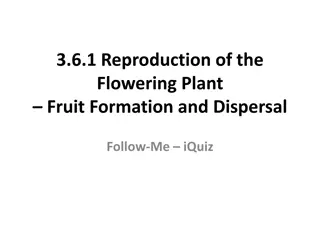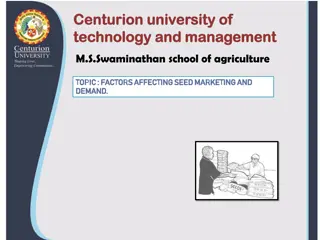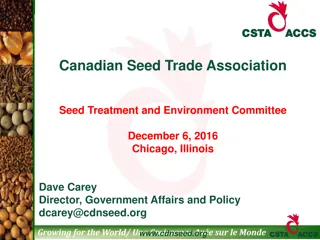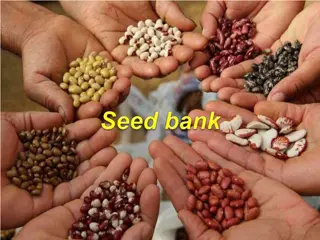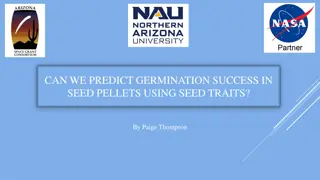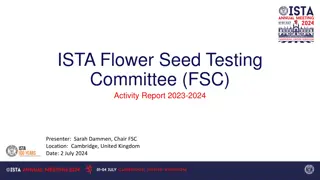Understanding Grow-Out Test for Genetic Purity Evaluation in Seed Certification
The Grow-Out Test is a crucial measure in seed certification to determine the genetic purity of seed lots. It helps in controlling genetic contaminations and ensuring compliance with prescribed standards. This test is essential for certain species like cotton, castor, musk melon, and brinjal in India. Samples are drawn following specific procedures, with recommended sample sizes varying based on species. The working sample is obtained through mixing and dividing the submitted sample, with a minimum plant population requirement of 400 for observations. Adjustments in seed rate are made based on germination percentage for obtaining the required number of plants.
Download Presentation

Please find below an Image/Link to download the presentation.
The content on the website is provided AS IS for your information and personal use only. It may not be sold, licensed, or shared on other websites without obtaining consent from the author. Download presentation by click this link. If you encounter any issues during the download, it is possible that the publisher has removed the file from their server.
E N D
Presentation Transcript
VARIETAL VARIETAL IDENTIFICATION IDENTIFICATION
To determine the genetic purity status of a given seed lot of the notified cultivar / hybrid and the extent to which the sample in question conforms to the prescribed standards.
FIELD OF APPLICABILITY FIELD OF APPLICABILITY Grow-out Test is the official measure for controlling the genetic purity of the seed lot. It serves as a pre- control as well as a post-control test for avoiding genetic contaminations. According regulations in India, it is pre-requisite for seed certification of hybrids of certain species such as cotton, castor, musk melon and brinjal. The test is required to be conducted for checking the sellers label with respect to genetic purity status of the seed lot under the provisions of the seeds Act 1966. In addition grow-out test can also be used as a measure to judge the efficacy of the certification agency or the inspector. to the official
Sampling Sampling The samples for Grow-out test shall be drawn simultaneously with the samples for other seed quality tests in accordance with the prescribed sampling procedures. Size Size of of submitted submitted sample sample The size of submitted samples shall vary according to the species as exemplified in this Table.
Recommended size of submitted sample for Recommended size of submitted sample for Grow Grow- -out Test out Test 1,000 g : 1,000 g : for maize, cotton, groundnut, soyabean and species of other genera with seeds of similar size; 500 g : 500 g : For sorghum, wheat, paddy and species of other genera with seeds of similar size; 250 g : Beet and species of other genera with seeds of similar size; 100 g : For bajra, jute and species of all other genera; 250 tubers / planting stakes / roots/ corms :-Seed potato, sweet potato and other vegetatively propagating crops.
Size of working sample Size of working sample The working sample for grow out test shall be obtained through subsequent mixing and dividing of the submitted sample in accordance with the prescribed procedure for seed sampling. The minimum population required for taking the observations shall be 400 plants; however, it will also depend on the maximum permissible off-type plants prescribed for the species under consideration in the Indian Minimum seed Certification standards The number of seeds required for raising the crop to obtain the required number of plants shall depend on the germination percentage of the seed sample and hence seed rate should be adjusted accordingly.
Maximum Maximum permissible permissible off types (%) off types (%) Minimum genetic Minimum genetic Purity (%) Purity (%) Number of Number of plants plants required per required per sample sample 4000 4000 2000 2000 1350 1350 800 800 400 400 0.10 0.10 0.20 0.20 0.30 0.30 0.50 0.50 99.9 99.9 99.8 99.7 99.7 99.5 99.5 1.00 and Above 1.00 and Above 99.0 and below 99.0 and below
Procedures Procedures achieve the reproducibility of the grow out test results, the procedures hereunder must be followed: To accuracy and provided Location Location of The grow out test shall be conducted in specified areas recommended for the cultivar / hybrid or in off-season nurseries. of the the grow grow out out test test
Standard sample Standard sample The standard sample of a cultivar (control) is the official standard against which all other samples of the seed of the cultivar will be judged. The standard sample must not differ significantly in any character and be obtained from the originating plant breeder / breeding institute and be stored under controlled temperature and humidity conditions so as to use it each year to sow control plots for cultivars under test. Further quantities of sample must be obtained from the originating plant breeder as and when required. A comparison must be made between the two lots of the standard sample before changing from one standard sample to other.
Method of raising the crop Method of raising the crop Standard and recommended agronomic / cultural practices such as field preparation, size of the plot, row length, distance between the rows, distance between the plants, irrigation and fertilization, etc., in respect of the specific crop shall be followed both for the sample in question and its control (standard sample). The germination percentage of the sample (s) in question and the standard sample must be determined to adjust the seed rate. The sowing should be done by dibbling or small plot drill. Seed drill must be carefully checked to ensure its cleanliness.
Subsequent thinnings is not recommended. The samples of the same cultivars must be sown in succession and the standard samples are sown at suitable intervals. (one standard sample for every ten sample to be tested). The size of the plot, row length and spacing shall differ according to the crop. Recommended specification for the above variables are provided in Table mentioned below which can suitably be modified if considered essential. The field plots should be grown in two replicates to guard against failure in one part of the field and to reduce environmental and soil fertility variations.
Methods for taking observations Methods for taking observations Grow-out test plots must be examined throughout the growing season with emphasis on the period from the flowering to ripening. All plants must be examined keeping in view the distinguishing characters described for the cultivars both in the test crop as well as the control. While taking the observation, the plants showing deviations in characters against the control should be tagged and examined carefully at a later stage to confirm whether they are off-types or not. The number of the total plants and the off-type plants found should be recorded.
Calculation and interpretation of the Calculation and interpretation of the results results Percentage of other cultivars, species or aberrants found must be calculated upto first decimal place. While interpreting the results, tolerances should be applied by using the reject number for prescribed standards with reference to sample size as provided in Table.
Reporting of results Reporting of results The results of the grow-out test shall be reported as percentage of other species, cultivars or off-type plants. If the sample is found to be a cultivar other than stated by the sender, the results shall be reported as such. If plants of other cultivars are more than 15 per cent, the report shall state that the sample consists of mixture of different cultivars. If nothing worthy of special comments is found, the report shall state that the results of the grow-out test of the sample in question revealed nothing to indicate that the name of the cultivar or species stated by the sender is incorrect.




